PAGEANT - "Education is the future"
JTT Nursery School
Background
JJT Nursery School was in Talinding, Serrekunda a few km from central Banjul. From 2005 on, Pageant member Aris Harrison-Price coordinated assistance given to the school by Nuneaton Lions Club, Ashby Castle Rotary Club, Coleman Primary School and other organisations in the Leicester area. In 2010 the African Oyster Trust built a new school on a new site, and the school changed its name to the Hilary Emery Nursery School. The continuing story of the new school is described on this Pageant webpage. Links on this page cover the story of both schools on both pages.
First Impressions - December 2005
In December 2005, Aris Harrison-Price was on holiday in The Gambia, when she was taken to see a local school by a tourist guide. This is a regular practice for tourist guides, and is exactly the way Pageant started back in 2000. The guide, Mbemba, took her to see JTT Nursery School in Serrekunda - essentially part of Greater Banjul. Although the Gambian Government provides primary and secondary education, parents must pay for nursery classes. This nursery school charges just £2 per term, which means that there is little or no money for equipment. Aris decided to start helping the school there and then, and to make it her personal project.
On return to the UK she enlisted the help of Nuneaton Lions Club, Ashby Castle Rotary Club, Coleman Primary School in Leicester, plus a lot of individuals and smaller groups in that area. Aris has since joined Pageant, who now provide admin and logistical help with what is still her project, and Mbemba is also still helping her with the school. The following is based on a Powerpoint presentation produced by Aris, and describes her first visit, and how she helped the schools in following years:
"When we first visited in December 2005, there were 138 children with 12 desks, 10 benches and a blackboard in a woefully tiny, bare, concrete block building, surrounded by a dangerous collection of pieces of discarded, rusty corrugated sheeting acting as fencing. There were no toilet or water facilities, and only 6 children with an exercise book and pencil. One teacher, known as Janko, was expected to teach the whole group, although he had enlisted the help of a 14-year-old boy, Ebou, to help with the youngest children. In July 2006, Ebou became apprenticed to a carpenter and could not be replaced, as there were no funds.
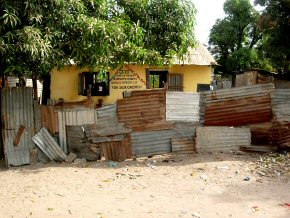
the school 'fence'
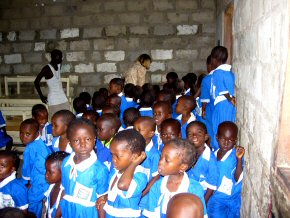
some of the children
This was the environment in which possible Gambian future leaders were being educated. There was no visual stimulus, no sanitary facilities, no safe surrounding fence, no equipment, 12 desks, 10 benches and one devoted teacher with a 14 year old boy to help 138 children.
Christmas 2005
Our first task was to equip all the children with a book and pencil. It was 23rd December 2005, and the last day of term before Christmas. We took a book and 2 pencils for each child. These were accepted with the same excitement that an English child might have shown for a new X BOX 360 that year!!
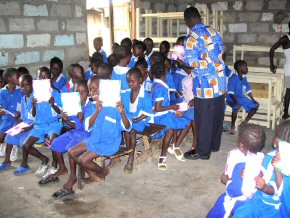
Next, we began the task of creating a more
stimulating, safe and hygienic educational environment.
A Model School - February 2006
I had noticed that few schools in the Gambia exhibited stimulating displays on their walls, so with the proceeds from the sale of my boat, I decided to make a return trip to the school in February 2006 to try to create a more stimulating classroom. Friends and relatives paid for the gloss paint, brushes and turps. Bargain Books of Ashby gave the school a superb poster and colouring folder. Ashby's Tesco store donated felt pens and pencils. All Saints Primary School in Coalville supplied paper, paints, shireseal and stencils to create pictures and posters for the classroom walls. Together with 30 non-European animal story books, the indulgence of a fun game of Twister, luminous skipping ropes and plastic balls, the extra charity weight allowance granted by Thomas Cook was considerably exceeded with the addition of considerable educational materials purchased from various charity shops.
We held a car-boot sale with contributions from generous friends, neighbours and acquaintances. In November 2006, toilets were built. These are the standard WHO approved local toilets, with no pedestal or flush facilities. They still need tiling on the floor to enable thorough cleaning. A further donation by the Packington Golf Club covered the cost of replacing the dangerous fence with a safe concrete block wall.
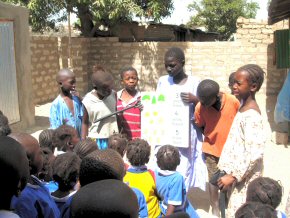
Tap to be installed
The Ashby Castle Rotary Club had donated sufficient to pay for the installation of a much needed water tap. One of my first tasks was to go with Mbemba, our 'Project Manager' to register the application and pay the deposit at the Water Division. He is holding the Registration Document with pride after his considerable efforts to make an appointment.
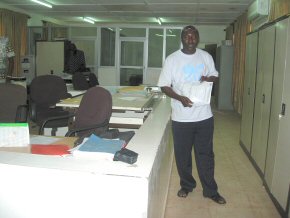
Painting the walls
The interior walls had been plastered in June 2006 with proceeds from the sale of 600 cakes baked by Coleman School in Leicester. On my first Saturday and Sunday, our team of local volunteers worked frantically to complete a basic wash plus both layers of gloss paint in time to dry sufficiently before school began again on Monday. Friends and relatives had donated funds for this, and we economised by using desks and a local giant, Suileman, instead of hiring ladders.
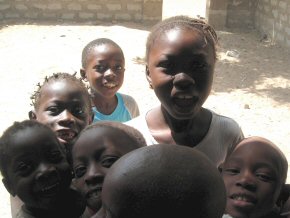
local children at the window
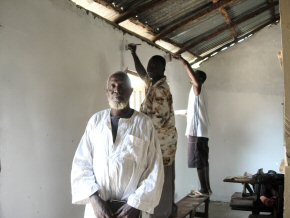
volunteers painting the walls
Local children peered in through the classroom window, curious about what we were doing. Parents came in to help and offer welcome glasses of green tea during the heat of Sunday afternoon. A steady flow of parents gave up part of their working days to offer some help throughout the following week.
Occasional mistakes were made (even by myself) for example when nos. 19 and 23 were found to have been left out only AFTER having reached no 30!! Fortunately, they had only been drawn in pencil at this stage and could at least be corrected!! Having concluded that colouring the letters and numbers in wax crayon was not too successful, red and blue gloss paint was used instead. It was less easy to apply, but most definitely more successful - and worth the aching shoulders for those who spent several hours with an arm raised uncomfortably high. (Oh, for a pair of ladders!)
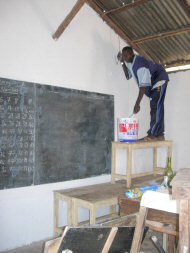
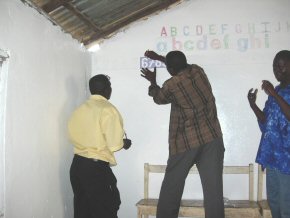
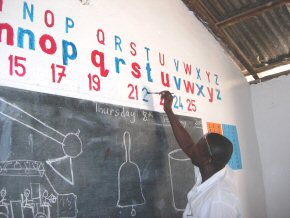
Ebou, the boy who had been the teacher's assistant during our first visit, but who is now an apprentice carpenter, heard about what we were doing and dropped in on his way home from work to help put the posters and pictures up.

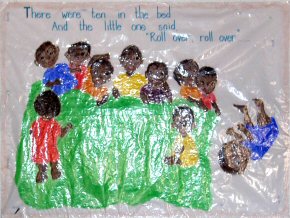
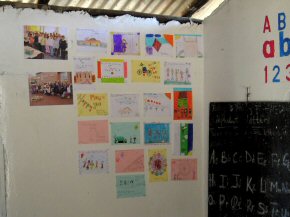
children's work
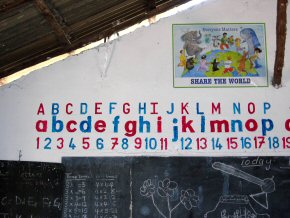
the completed front wall
The rear wall had been designated as a maths and science area. I was suddenly reminded of the fact that we were in a country still steeped in the belief in witchcraft and voodoo. The teacher explained that only by placing this humorous skeleton behind him, could he convince the children there was nothing to be afraid of.
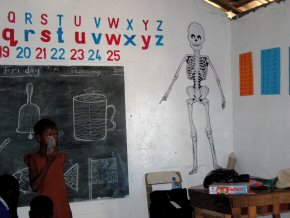
Since the classroom is so small, nearly all the 28 kgs of equipment we had brought would have to be used in the shaded part of the playground. We had to protect it against the dusty, sand surface. Plywood and lino were chosen. They needed to be cut to size, which was done for us by the local carpenter.
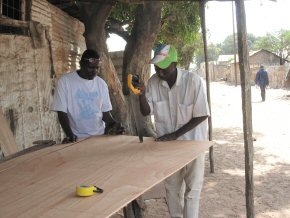
Tesco's felt pens and pencil crayons enabled children to experiment with colours; we even had purple and green giraffes on the poster book gift from Ashby Bargain Books!! It wasn't that they didn't know which colours to use. There was, after all, a huge picture of a giraffe on the wall. It was simply that the children wanted to use every colour they could!!
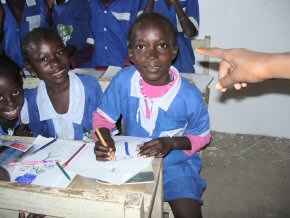
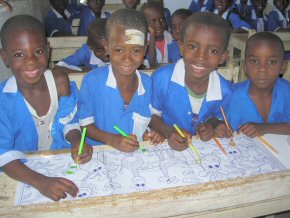
Fridays are only ½ day at school as the mainly Muslim population attend Friday prayers at the mosque in the afternoons. For this reason, Fridays are usually only used for singing and revision of times tables. With the gift of 30 beautifully illustrated story books, the teacher has begun to make Fridays a story, singing and tables day. The children had never seen a text book or story book before!! They were spell bound.
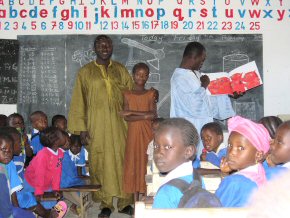
Totally New Experiences
Although we knew the school had no equipment, it was quite a shock to discover that even the teacher had NEVER BEFORE seen some of the things we had brought! He spent 3½ hours one evening learning how to use a shape sorter, play maths skittles, build with a Duplo type kit, try different skipping and ball games, do alphabet and number jigsaws and read through the story books. It took a surprising amount of time for the children to learn how to use the equipment. After all, they had never had anything like this. Even at home, there are no toys.
Stones are used as footballs and were the nearest thing to a toy that was seen during the visit. A ball was only viewed as part of a game of football, so we taught the children how to throw and catch, plus other non-kicking games. The teacher mentioned that someone had given the school just 1 skipping rope a couple of years ago, but it had soon broken, so we were really pleased to see the pleasure the children were getting from learning to use those which we had brought.

playing ball
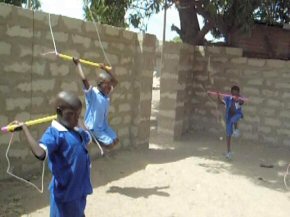
skipping
After 1½ hrs. experimenting, children were still finding the concept of joining and building with the large Duplo bricks very difficult, despite the fact that Mbemba and I had demonstrated earlier.
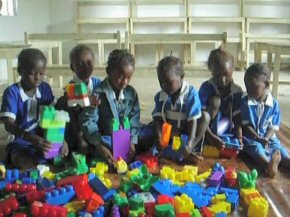
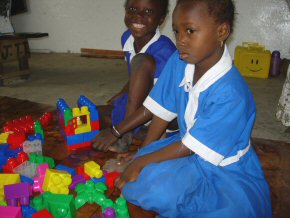
A simple shape sorter for 2 yr olds took all the concentration and considerable effort for the 8 yr. olds to complete. We have a video clip showing them solving this challenge. Placing jigsaw pieces together, for an alphabet train and a number puzzle, became a major learning task. There is a video clip showing children solving the shape sorter puzzle. See our clips index for other clips.
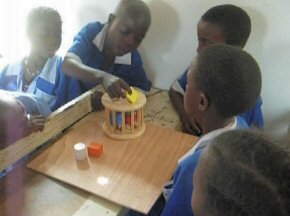
shape sorter
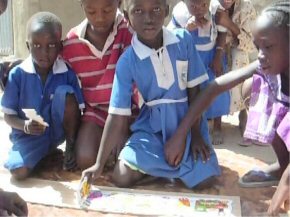
alphabet train
Throwing a ball to knock down and count totals on maths skittles was a skill that had to be taught, as they had no concept of the fact that only by rolling the ball could they hope to knock down skittles.
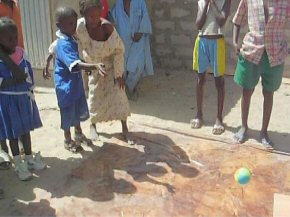
maths skittles
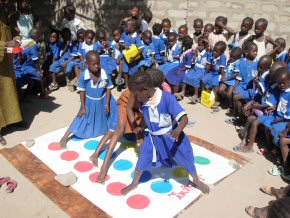
Twister
Having no p.e. equipment, the balls and skipping ropes are going to provide opportunities for some exercise for some time. However, there was one indulgence we couldn't resist taking and calling p.e. equipment - a game of Twister. Well, you need to be supple and fit to play it, don't you? The children were delighted. School had finished and usually the children disappeared within seconds. We asked if anyone would like to stay to play a game.... Benches were brought outside and more than 1 hour later we had to shoo the children home so that they wouldn't be late for Friday prayers!!!!! I think that Twister is as popular now at JTT School as anywhere here in England.
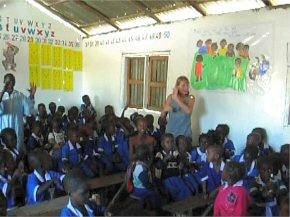
nursery rhymes
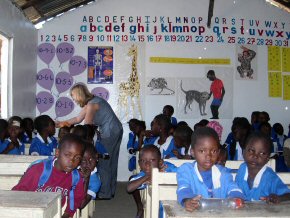
handing out the sweets
We had great fun teaching the children: 'There were 10 in the bed' and 'The wheels on the bus' and they thought the nursery rhyme posters very funny. A donation, specifically for sweets, enabled us to give some out on the first and last day of our work at the school, and were able to leave some for the following week, too; an extremely rare treat!!
Problems still to be resolved
- As work was being carried out during normal school times, with class being held in the playground, we were able to witness the incredible problems the teacher was having trying to teach more than 130 children unaided. A second qualified teacher would cost us £35 monthly, but an assistant at least is vital, and as soon as possible
- We had already replaced four panels of corrugated roofing, but I was very aware that every other panel had holes. If all our work is not to be destroyed during the summer's torrential rains, we need to replace the remaining panels
- The toilets need a flooring which can be washed down effectively each day
- With only 12 desks even with 4 children to each, more furniture is greatly needed.
Around the School
A New Assistant
Natoma Sanyang is nearly 20, has completed all her schooling and covered a 2 year computer course. She is intelligent, eager and very good with children. She has been unable to get a job because in a country where there are as yet so few jobs using computers, she is considered too young. I explained that she would be employed from as soon as we could raise 12 months of the £15 monthly salary and this has now been achieved. She is delighted by our offer and walks to school from the far side of Serrekunda each day, a 35 minute journey each way.
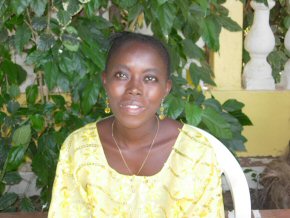
Natoma
Children come to the JTT School from several compounds. The owner of the school land, Ebrima Camara, lives in the compound adjoining the school, where many of the children live. Most people were at Friday prayers when I visited, but those who were there were happy to show off their compound with pride.
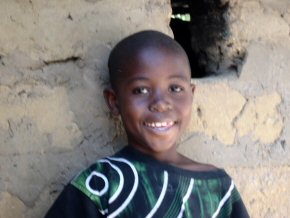
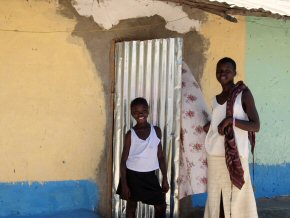

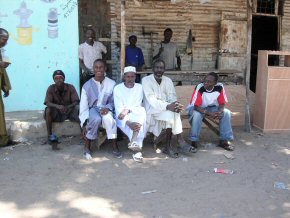
The Compound garden grows herbs and a few vegetables. The well cannot be depended upon during the dry months, and the nearest tap is almost ½ mile away.

the gardens
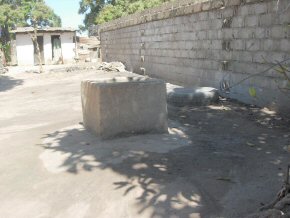
the well
Ebrima Camara is almost blind and too old to work now. He was eager to show us the roof of his home. He can't afford corrugated sheeting, so it is covered in pieces of polythene, which leak during the rainy season.

Ebrima's house
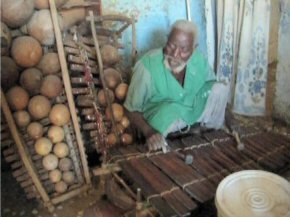
Ebrima and his xylophones
There were 3 rooms. One contained a gleaming cooking pot so proudly shown by Ebrima's wife. Another had a bed and a shelf unit on which were stacked the family's entire possessions, apart from the old man's 3 xylophones which had once provided him with an income as a musician. A third room had a mattress on the floor. And this was the most important family of the compound."

That's the end of text and photos taken from Aris Harrison-Price's presentation.
November 2008 Update - New desks and roof
JTT received six tables and ten chairs, a part of the furniture donated by Southwater County Infants' School (see details), Janko, the head teacher, wrote to say how delighted he was to receive them, and the children's faces (below left) suggest that the chairs are a perfect fit!! The locally built desks (below right) were paid for by the Ashby Coffee Pot Club and members of the Country Colours Art Group. In the past, 48 children had sat four to a table, and those remaining had only long benches upon which they sat and worked on their laps. The new furniture enables 94 children to work at a table or desk with only the very youngest left still on benches alone. We hope to provide for more desks or tables for them in the future.
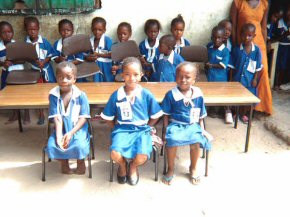
furniture from Southwater
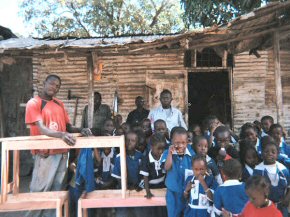
locally built desks
We told you earlier about Natoma Sanyang, who is working at the school as a teaching assistant. Since April 2007 her salary has been paid for by various generous individuals and by the children at Castle Donington Community College. They held a sponsored walk day, and also raised money by baking and selling cakes to pay for 13 months of Natoma's salary. Funding is now secure until November 2009.
The photos show Natoma teaching and with some of the children.
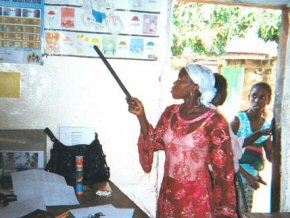
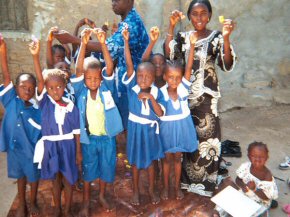
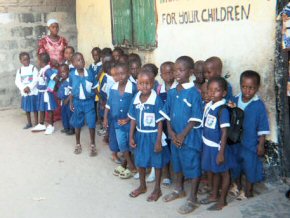
Aris had an enjoyable dinner and evening with Nuneaton Lions Club as their after dinner speaker. Their donation helped to replace the rusted, holed roof, and also contributed towards some of Natoma's first few month's salary.
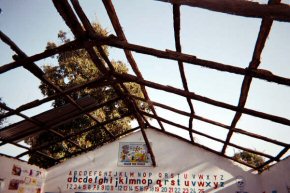

Aris gave a talk and PowerPoint presentation to the Ashby Castle Rotary Club. To her delight, as well as the £25 fee, they were so moved that they gave a cheque for £300 towards the cost of installing the tap. The water bill, always less than 100 Dalasis, is shared by the school and the landlord.
The PE or play parachute is used in the UK by Nursery schools, after school groups, Brownie packs etc. as a fun way of providing exercise for young children. Aris bought this for the JTT children as an end of Ramadan present.
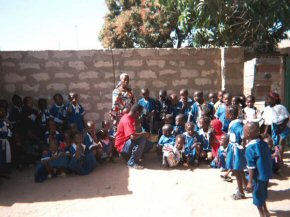
the new tap, funded by Ashby Castle Rotary club
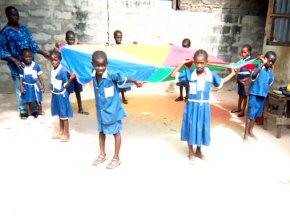
the PE parachute
Whiteboards (see below) are essentially an updated version of the old-fashioned slate. They save on the expense of paper, and are appropriate technology for JTT which doesn't have electricity for hi-tech equipment.
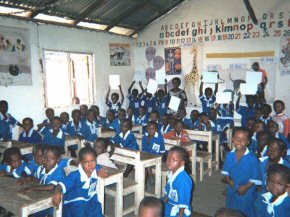
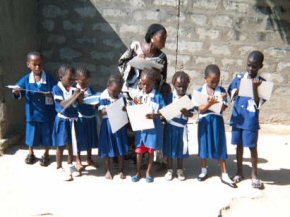
April 2010 Update - University course for JTT's teachers
Aris Harrison-Price has sent us an update of news and photos from JTT Nursery School. She is no longer able to undertake major fundraising for the school, but she and Nigel are continuing to pay the salary for Natoma, the assistant teacher they employed three years ago.
Aris learned from a group called The African Oyster Trust, run by Lady Kira Dalton, that there was a possibility of sending both Natoma and Janko (the school's head-teacher) on the Early Childhood Development Diploma course at the Brikama College. Kira has considerable projects of her own (schools, hospital, medical centre etc) and lives in The Gambia for about eight months of the year. She offered to go and chat with JTT's two teachers, to establish that they had sufficient enthusiasm to warrant spending £1000 on their 3 year course. When she arrived, a hornets nest was opened, and to sum up, she decided that the African Oyster Trust would be prepared to help financially. The school building has always been far too small for the number of children. There are currently 134 on the roll - too many for just two teachers. Despite having had more desks built and some donated through Pageant, there wasn't enough room to use them or much of the equipment that Aris had taken out, so most of this is stored away.
Kira was very impressed by both Natoma's and Janko's dedication to their work, and extremely impressed by the children's level of achievement particularly under the constraints of the building. She invited Janko and Natoma to visit the schools supported by the African Oyster trust so that they could see different methods of teaching and to discuss the college course, so they could make an informed decision whether to commit themselves to the course. It is a very intensive course, involving attending in the early morning five days a week throughout the ENTIRE school holidays for three years - not a decision to be taken lightly, but one which can change their lives and make their futures much more secure. Having made the visits, they are ecstatic at the prospect. Aris and Nigel will be covering the £1000 course fees, as well as continuing to pay Natoma's salary.
A new school!
Meanwhile, Kira Dalton had a meeting with the Mayor of Talinding to discuss the possibility of moving to a new school building. This agreed upon, she then took it upon herself to search for a suitable site. She negotiated the rental of some land attached to another compound upon which to build the new school. It will have three good sized, separate classrooms plus washing and toilet facilities. There is already a partially constructed building on site, which will be completed to create a home for the Headteacher, and safe storage for school equipment. The new building will be named after the late Hilary Emery, as donations in her memory will fund the building. Work has already started, and the school hope to move in for the new academic year this autumn.
With the school moving to new premises, and changing its name, we will continue to tell the school's story on this new Hilary Emery Nursery School page.